X1.6 solar flare from sunspot region 2192
Wednesday, 22 October 2014 15:15 UTC
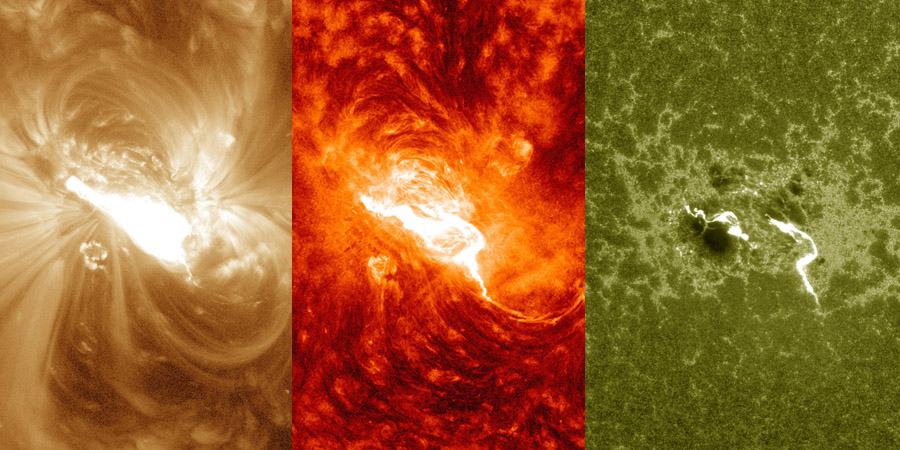
Sunspot region 2192 (now the largest sunspot region of this solar cycle) produced a major X1.67 solar flare (R3-strong radio blackout) at 14:28 UTC. This was the second and also the strongest X-class solar flare from this sunspot region and the 19th strongest solar flare of the current solar cycle. Sunspot region 2192 was also the source of two M-class solar flares today: M8.7 at 01:59 UTC and M2.7 at 05:17 UTC.
Coronagraph imagery is not yet available to confirm the launch of a coronal mass ejection but the lack of any significant coronal dimming (traces in the solar corona of ejected material) suggests there might not be a major coronal mass ejection associated with this event despite the long duration of the solar flare. The magnetic loops holding this group together just do not want to break and release a coronal mass ejection it seems, just like all other previous solar flares (including today's M-class solar flares) also failed to produce a coronal mass ejection. This is a shame as sunspot region 2192 is now in a great position for any eruptions to be earth-directed but we do need to wait for coronagraph imagery from SOHO to be 100% sure that there is again no coronal mass ejection. This post will be updated as soon as more information becomes available so keep checking back.
X1.6 solar flare video (ADDED 17:00 UTC)
Here is a video of the major X1.6 solar flare that peaked today at 14:28 UTC in the 193 Ångström wavelength as seen by NASA Solar Dynamics Observatory.
Why are we showing the X1.6 solar flare in the 193 Ångström wavelength? Well, this wavelength shows us the solar corona and the corona can tell us a few things about a solar flare/coronal mass ejection before we even get coronagraph imagery from spacecraft like STEREO or SOHO.
Normally we can see during eruptive solar events that the corona is being disturbed. We see darkening of the corona when a coronal mass ejection is launched, a shock wave can also be seen often and erupting loops which later get rebuild. In this video you can clearly see that nothing of that happens during or after the X1.6 solar flare. There is no shock wave, no coronal darkening and the coronal loops just stay where they are. There are no signs at all of a disturbance in the solar corona. This tells us that there might not be a coronal mass ejection associated with this solar flare before we even get coronagraph imagery. Sad news but it is how it is!
NOAA SWPC alerts regarding the X1.6 solar flare
ALERT: X-Ray Flux exceeded M5 Threshold Reached: 2014 Oct 22 1409 UTC NOAA Scale: R2 - Moderate
SUMMARY: 10cm Radio Burst Begin Time: 2014 Oct 22 1405 UTC Maximum Time: 2014 Oct 22 1406 UTC End Time: 2014 Oct 22 1409 UTC Duration: 4 minutes Peak Flux: 200 sfu Latest Penticton Noon Flux: 199 sfu
SUMMARY: X-ray Event exceeded X1 Begin Time: 2014 Oct 22 1402 UTC Maximum Time: 2014 Oct 22 1428 UTC End Time: 2014 Oct 22 1450 UTC X-ray Class: X1.6 Optical Class: 2b Location: S14E13 NOAA Scale: R3 - Strong
Evolution of sunspot region 2192
Penumbral growth is seen in the western part of the sunspot group with several new sunspots forming. The eastern part remains stable as well in both sunspot size and penumbral size. Further separation between the two polarity zones is still ongoing, breaking and crumbling the penumbral area in between. Some new tiny delta spots are also spotted within the region (indicated with the arrows on the image).
One very curious thing with this sunspot region that many of you asked about is that sunspot region 2192 fails to produce any coronal mass ejections. The loops that stretch out this sunspot region remain tightly connected and don't break. Due to that no coronal mass is ejected into space during the solar flares. Now that this sunspot region rotates into geo-effective position, it is likely that any future coronal mass ejections come towards Earth but it seems like we need an even stronger solar flare for this to happen... There is also increases the chance for a proton event >=S1. Sunspot region 2192 remains capable of producing M-class solar flares with a chance for a low (R3) X-class event.
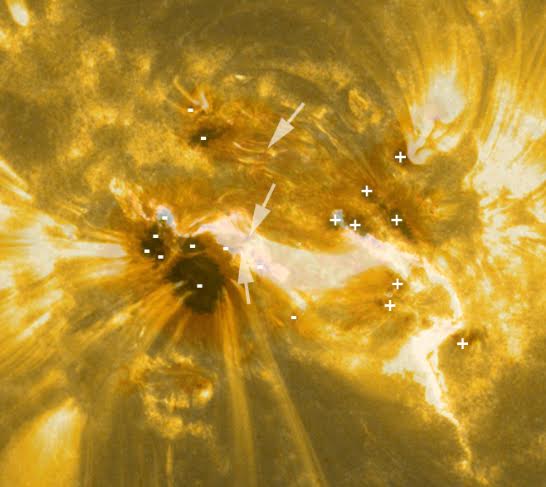
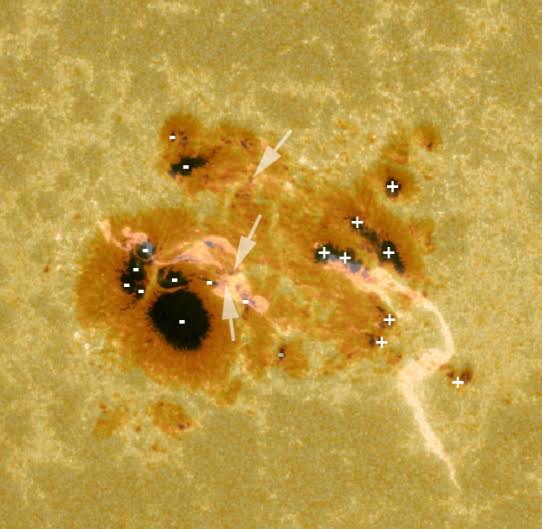
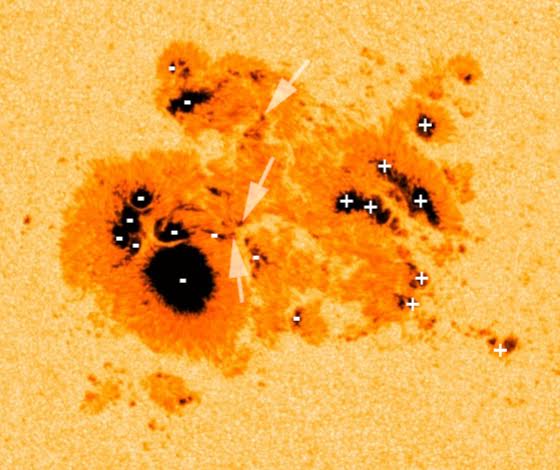
The video below demonstrates how sunspot region 2192 developed as it started to rotated over the eastern limb of the Sun and into our view here.
All the other sunspot regions on the disk are unremarkable. Any future solar flares will very likely be centered around sunspot region 2192 which is now directly facing Earth.
Images and video: NASA SDO.
Solar flare odds for the coming 24 hours
M-class flare probability: 60% chance
X-class flare probability: 10% chance
Geomagnetic conditions
Geomagnetic conditions remain elevated thanks to continuing coronal hole effects. Active geomagnetic conditions (Kp4) were reached during the past 24 hours which sparked aurora over many high latitude locations in Europe and North-America. This stunning image below was captured last evening by Art by T.Richardsen from northern Norway.

The solar wind speed remains elevated near 450km/s with a minor southward directed IMF component. This solar wind stream came from the first of two coronal holes that were earth-facing and we will likely soon see the arrival of a second solar wind stream. Active (Kp4) geomagnetic conditions remain possible. Sky watchers in Scotland, Norway, large parts of Sweden, Finland and those near the US-Canadian border should remain alert for aurora as coronal hole effects continue to influence space weather near Earth.
M1.4 solar flare behind eastern limb (ADDED 16:15 UTC)
During the declining phase of the X1.6 event there was an M1.4 solar flare peaking at 15:57 UTC from a new sunspot region just behind the east limb. Is there another sunspot region of interest about to show itself?
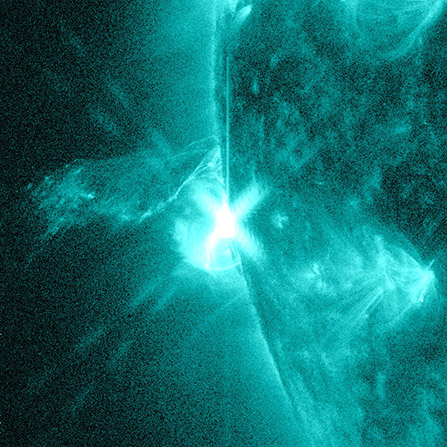
Image: NASA SDO.
Thank you for reading this article! Did you have any trouble with the technical terms used in this article? Our help section is the place to be where you can find in-depth articles, a FAQ and a list with common abbreviations. Still puzzled? Just post on our forum where we will help you the best we can!
Latest news
Latest forum messages
More topicsSupport SpaceWeatherLive.com!
A lot of people come to SpaceWeatherLive to follow the Sun's activity or if there is aurora to be seen, but with more traffic comes higher server costs. Consider a donation if you enjoy SpaceWeatherLive so we can keep the website online!

Space weather facts
| Last X-flare | 2025/03/28 | X1.1 |
| Last M-flare | 2025/04/01 | M5.6 |
| Last geomagnetic storm | 2025/03/27 | Kp5 (G1) |
| Spotless days | |
|---|---|
| Last spotless day | 2022/06/08 |
| Monthly mean Sunspot Number | |
|---|---|
| February 2025 | 154.6 +17.6 |
| Last 30 days | 128.5 -22.7 |


